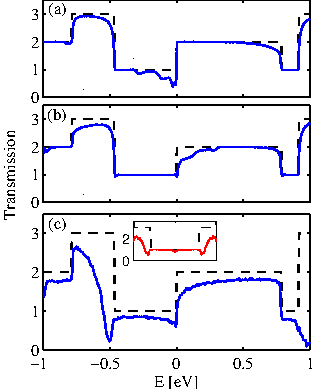



Next: 3.3.3 The Role of Line-Edge-Roughness
Up: 3.3 Thermoelectrics Engineering in ZGNRs
Previous: 3.3.1 The Role of Extended Line Defects
Contents
The possibility of further
enhancing the asymmetry between electron and hole transport near the
Fermi level by the introduction of positively charged substrate background
impurities is examined. The effect of background impurities is included in the
Hamiltonian in a simplified way as an effective negative long range
potential energy on the appropriate on-site Hamiltonian elements as
described in Ref. [88]. A positive impurity in the
substrate will constitute a repulsive potential for holes (a barrier
for holes but a well for electrons) and will degrade hole transport
more effectively than electron
transport. Figure. 3.22-a shows how the
transmission of the ELD-ZGNR(10,10) channel (dashed-black line) is
affected after the introduction of positive charged impurities in the
channel (solid-blue line). Indeed, the transmission of holes below the
Fermi level (
 ) is degraded. This effect additionally
increases the asymmetry of the propagating bands and improves the Seebeck
coefficient. On the other hand, the opposite is observed when negative
impurities are introduced in the substrate. Negative impurities are a
barrier for electrons and reduce their
transmission [94], but do not interfere with the hole
subsystem as shown in Fig. 3.22-b. This type of
impurities will actually harm the asymmetry and needs to be avoided.
) is degraded. This effect additionally
increases the asymmetry of the propagating bands and improves the Seebeck
coefficient. On the other hand, the opposite is observed when negative
impurities are introduced in the substrate. Negative impurities are a
barrier for electrons and reduce their
transmission [94], but do not interfere with the hole
subsystem as shown in Fig. 3.22-b. This type of
impurities will actually harm the asymmetry and needs to be avoided.
Figure 3.22:
The effect of (a) positive substrate impurity, (b) negative
substrate impurity, and (c) roughness on the transmission of
ELD-ZGNR(10,10) with length of
 . Inset of (c):
The transmission of ZGNR(20) in the presence of roughness.
. Inset of (c):
The transmission of ZGNR(20) in the presence of roughness.
|
|




Next: 3.3.3 The Role of Line-Edge-Roughness
Up: 3.3 Thermoelectrics Engineering in ZGNRs
Previous: 3.3.1 The Role of Extended Line Defects
Contents
H. Karamitaheri: Thermal and Thermoelectric Properties of Nanostructures

